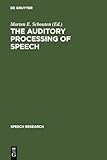The Auditory Processing of Speech : From Sounds to Words / ed. by Marten E. Schouten.
Material type: TextSeries: Speech Research ; 10Publisher: Berlin ; Boston : De Gruyter Mouton, [2011]Copyright date: ©1992Edition: Reprint 2011Description: 1 online resource (380 p.) : Num. figs. and tabsContent type:
TextSeries: Speech Research ; 10Publisher: Berlin ; Boston : De Gruyter Mouton, [2011]Copyright date: ©1992Edition: Reprint 2011Description: 1 online resource (380 p.) : Num. figs. and tabsContent type: - 9783110135893
- 9783110879018
- 401/.9 20
- BF463.S64 A9 1992eb
- online - DeGruyter
- Issued also in print.
| Item type | Current library | Call number | URL | Status | Notes | Barcode | |
|---|---|---|---|---|---|---|---|
 eBook
eBook
|
Biblioteca "Angelicum" Pont. Univ. S.Tommaso d'Aquino Nuvola online | online - DeGruyter (Browse shelf(Opens below)) | Online access | Not for loan (Accesso limitato) | Accesso per gli utenti autorizzati / Access for authorized users | (dgr)9783110879018 |
Browsing Biblioteca "Angelicum" Pont. Univ. S.Tommaso d'Aquino shelves, Shelving location: Nuvola online Close shelf browser (Hides shelf browser)

|

|

|

|

|

|

|
||
| online - DeGruyter Schleiermachers Theorie der Frömmigkeit : Ihr wissenschaftlicher Ort und ihr systematischer Gehalt in den Reden, in der Glaubenslehre und in der Dialektik / | online - DeGruyter Management in Western Europe : Society, Culture and Organization in Twelve Nations / | online - DeGruyter Analysis and Synthesis of Speech : Strategic Research towards High-Quality Text-To-Speech Generation / | online - DeGruyter The Auditory Processing of Speech : From Sounds to Words / | online - DeGruyter Aspects of Oral Communication / | online - DeGruyter Gesammelte Schriften. Band 2. Werke. 1796–1799 / | online - DeGruyter Gesammelte Schriften. Band 9. Werke. Gedichte / |
I-IV -- Preface -- Table of Contents -- Editor's Introduction -- Chapter 1 The Auditory System in Relation to Speech Perception -- Cochlear Modelling and Physiology -- Coding of Fundamental Frequency in Auditory Nerve Fibers: Effects of Signal Level and Phase Spectrum. -- Coding of the Pitch of Harmonic and Inharmonic Complex Tones in the Interspike Intervals of Auditory-Nerve Fibers. -- Processing of the Auditory-Nerve Code for Speech by Populations of Cells in the Anteroventral Cochlear Nucleus -- Nonlinearities in the Peripheral Encoding of Spectral Notches -- Auditory Models as Preprocessors for Speech Recognition -- Temporal Resolution and Modulation Analysis in Models of the Auditory System -- Preadaptations in the Auditory System of Mammals for Phoneme Perception -- Chapter 2 Separation of Simultaneous Signals -- Segregation of the Responses to Paired Vowels in the Auditory Nerve of the Guinea-Pig Using Autocorrelation -- Modelling Sound Source Separation -- Listening to two Things at Once -- Detecting F0 Differences and Pitch-Pulse Asynchronies -- Roles of Harmonicity and Coherent Frequency Modulation in Auditory Grouping. -- Comodulation Masking Release and Modulation Discrimination Interference -- Across-band Processing of Dynamically Varying Stimuli -- Effectiveness of Comodulation Masking Release -- The Masking of Modulations in Relation to Speech Perception -- Chapter 3 Perception of Spectral Change and Timbre -- What Do We Know about Perception of Dynamic and Complex Signals, and how Relevant Is It to Speech Perception? -- On the Perception of Spectral Changes in Noise Bands -- Young Infants' Discrimination of Confusable Speech Signals -- Auditory Analysis of Speech Gestures -- Perceiving Acoustic Components of Speech -- Chapter 4 Loss of Spectral and Temporal Resolution -- Speech Recognition Using Only Temporal Cues -- Auditory Pattern Perception in the Profoundly Hearing Impaired -- Effect of Spectral Envelope Smearing on Phoneme Identification -- Chapter 5 Phoneme Perception -- Effects of Token Variability on Vowel Identification -- Evaluation of Prototypes and Exemplars in Perceptual Space for Place Contrast -- Different Discrimination Strategies for Vowels and Consonants -- Auditory Metrics for Speech Perception -- Chapter 6 Word Perception and Beyond -- The Interface Between Acoustic-Phonetic and Lexical Processing -- Listening to Speech Through an Adaptive Window of Analysis -- Integration of Acoustic-Phonetic Cues in Word Segmentation -- Relations between Phoneme Scores and Syllable Scores for Normal-Hearing and Hearing-Impaired Subjects -- From Speech to Language: On Auditory Information Processing -- 381-382
restricted access online access with authorization star
http://purl.org/coar/access_right/c_16ec
Issued also in print.
Mode of access: Internet via World Wide Web.
In English.
Description based on online resource; title from PDF title page (publisher's Web site, viewed 29. Jun 2022)


